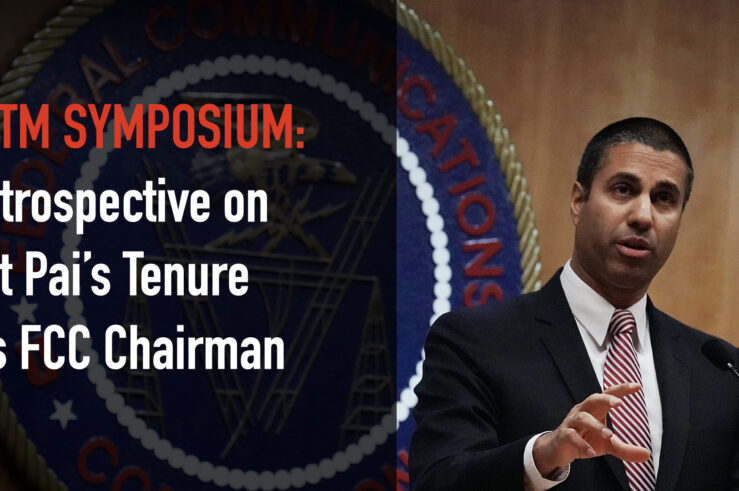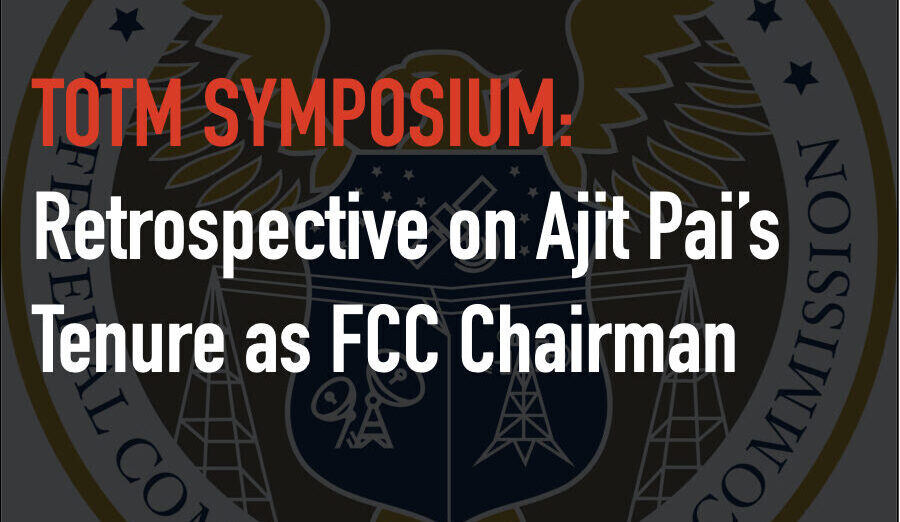
This article is a part of the Retrospective on Ajit Pai's Tenure as FCC Chairman symposium.

I’m delighted to add my comments to the chorus of voices honoring Ajit Pai’s remarkable tenure at the Federal Communications Commission. I’ve known Ajit longer than most. We were classmates in law school … let’s just say “many” years ago. Among the other symposium contributors I know of only one—fellow classmate, Tom Nachbar—who can make a similar claim. I wish I could say this gives me special insight into his motivations, his actions, and the significance of his accomplishments, but really it means only that I have endured his dad jokes and interminable pop-culture references longer than most.
But I can say this: Ajit has always stood out as a genuinely humble, unfailingly gregarious, relentlessly curious, and remarkably intelligent human being, and he deployed these characteristics to great success at the FCC.
Ajit’s tenure at the FCC was marked by an abiding appreciation for the importance of competition, both as a guiding principle for new regulations and as a touchstone to determine when to challenge existing ones. As others have noted (and as we have written elsewhere), that approach was reflected significantly in the commission’s Restoring Internet Freedom Order, which made competition—and competition enforcement by the antitrust agencies—the centerpiece of the agency’s approach to net neutrality. But I would argue that perhaps Chairman Pai’s greatest contribution to bringing competition to the forefront of the FCC’s mandate came in his work on media modernization.
Fairly early in his tenure at the commission, Ajit raised concerns with the FCC’s failure to modernize its media-ownership rules. In response to the FCC’s belated effort to initiate the required 2010 and 2014 Quadrennial Reviews of those rules, then-Commissioner Pai noted that the commission had abdicated its responsibility under the statute to promote competition. Not only was the FCC proposing to maintain a host of outdated existing rules, but it was also moving to impose further constraints (through new limitations on the use of Joint Sales Agreements (JSAs)). As Ajit noted, such an approach was antithetical to competition:
In smaller markets, the choice is not between two stations entering into a JSA and those same two stations flourishing while operating completely independently. Rather, the choice is between two stations entering into a JSA and at least one of those stations’ viability being threatened. If stations in these smaller markets are to survive and provide many of the same services as television stations in larger markets, they must cut costs. And JSAs are a vital mechanism for doing that.
The efficiencies created by JSAs are not a luxury in today’s digital age. They are necessary, as local broadcasters face fierce competition for viewers and advertisers.
Under then-Chairman Tom Wheeler, the commission voted to adopt the Quadrennial Review in 2016, issuing rules that largely maintained the status quo and, at best, paid tepid lip service to the massive changes in the competitive landscape. As Ajit wrote in dissent:
The changes to the media marketplace since the FCC adopted the Newspaper-Broadcast Cross-Ownership Rule in 1975 have been revolutionary…. Yet, instead of repealing the Newspaper-Broadcast Cross-Ownership Rule to account for the massive changes in how Americans receive news and information, we cling to it.
And over the near-decade since the FCC last finished a “quadrennial” review, the video marketplace has transformed dramatically…. Yet, instead of loosening the Local Television Ownership Rule to account for the increasing competition to broadcast television stations, we actually tighten that regulation.
And instead of updating the Local Radio Ownership Rule, the Radio-Television Cross-Ownership Rule, and the Dual Network Rule, we merely rubber-stamp them.
The more the media marketplace changes, the more the FCC’s media regulations stay the same.
As Ajit also accurately noted at the time:
Soon, I expect outside parties to deliver us to the denouement: a decisive round of judicial review. I hope that the court that reviews this sad and total abdication of the administrative function finds, once and for all, that our media ownership rules can no longer stay stuck in the 1970s consistent with the Administrative Procedure Act, the Communications Act, and common sense. The regulations discussed above are as timely as “rabbit ears,” and it’s about time they go the way of those relics of the broadcast world. I am hopeful that the intervention of the judicial branch will bring us into the digital age.
And, indeed, just this week the case was argued before the Supreme Court.
In the interim, however, Ajit became Chairman of the FCC. And in his first year in that capacity, he took up a reconsideration of the 2016 Order. This 2017 Order on Reconsideration is the one that finally came before the Supreme Court.
Consistent with his unwavering commitment to promote media competition—and no longer a minority commissioner shouting into the wind—Chairman Pai put forward a proposal substantially updating the media-ownership rules to reflect the dramatically changed market realities facing traditional broadcasters and newspapers:
Today we end the 2010/2014 Quadrennial Review proceeding. In doing so, the Commission not only acknowledges the dynamic nature of the media marketplace, but takes concrete steps to update its broadcast ownership rules to reflect reality…. In this Order on Reconsideration, we refuse to ignore the changed landscape and the mandates of Section 202(h), and we deliver on the Commission’s promise to adopt broadcast ownership rules that reflect the present, not the past. Because of our actions today to relax and eliminate outdated rules, broadcasters and local newspapers will at last be given a greater opportunity to compete and thrive in the vibrant and fast-changing media marketplace. And in the end, it is consumers that will benefit, as broadcast stations and newspapers—those media outlets most committed to serving their local communities—will be better able to invest in local news and public interest programming and improve their overall service to those communities.
Ajit’s approach was certainly deregulatory. But more importantly, it was realistic, well-reasoned, and responsive to changing economic circumstances. Unlike most of his predecessors, Ajit was unwilling to accede to the torpor of repeated judicial remands (on dubious legal grounds, as we noted in our amicus brief urging the Court to grant certiorari in the case), permitting facially and wildly outdated rules to persist in the face of massive and obvious economic change.
Like Ajit, I am not one to advocate regulatory action lightly, especially in the (all-too-rare) face of judicial review that suggests an agency has exceeded its discretion. But in this case, the need for dramatic rule change—here, to deregulate—was undeniable. The only abuse of discretion was on the part of the court, not the agency. As we put it in our amicus brief:
[T]he panel vacated these vital reforms based on mere speculation that they would hinder minority and female ownership, rather than grounding its action on any record evidence of such an effect. In fact, the 2017 Reconsideration Order makes clear that the FCC found no evidence in the record supporting the court’s speculative concern.
…In rejecting the FCC’s stated reasons for repealing or modifying the rules, absent any evidence in the record to the contrary, the panel substituted its own speculative concerns for the judgment of the FCC, notwithstanding the FCC’s decades of experience regulating the broadcast and newspaper industries. By so doing, the panel exceeded the bounds of its judicial review powers under the APA.
Key to Ajit’s conclusion that competition in local media markets could be furthered by permitting more concentration was his awareness that the relevant market for analysis couldn’t be limited to traditional media outlets like broadcasters and newspapers; it must include the likes of cable networks, streaming video providers, and social-media platforms, as well. As Ajit put it in a recent speech:
The problem is a fundamental refusal to grapple with today’s marketplace: what the service market is, who the competitors are, and the like. When assessing competition, some in Washington are so obsessed with the numerator, so to speak—the size of a particular company, for instance—that they’ve completely ignored the explosion of the denominator—the full range of alternatives in media today, many of which didn’t exist a few years ago.
When determining a particular company’s market share, a candid assessment of the denominator should include far more than just broadcast networks or cable channels. From any perspective (economic, legal, or policy), it should include any kinds of media consumption that consumers consider to be substitutes. That could be TV. It could be radio. It could be cable. It could be streaming. It could be social media. It could be gaming. It could be still something else. The touchstone of that denominator should be “what content do people choose today?”, not “what content did people choose in 1975 or 1992, and how can we artificially constrict our inquiry today to match that?”
For some reason, this simple and seemingly undeniable conception of the market escapes virtually all critics of Ajit’s media-modernization agenda. Indeed, even Justice Stephen Breyer in this week’s oral argument seemed baffled by the notion that more concentration could entail more competition:
JUSTICE BREYER: I’m thinking of it solely as a — the anti-merger part, in — in anti-merger law, merger law generally, I think, has a theory, and the theory is, beyond a certain point and other things being equal, you have fewer companies in a market, the harder it is to enter, and it’s particularly harder for smaller firms. And, here, smaller firms are heavily correlated or more likely to be correlated with women and minorities. All right?
The opposite view, which is what the FCC has now chosen, is — is they want to move or allow to be moved towards more concentration. So what’s the theory that that wouldn’t hurt the minorities and women or smaller businesses? What’s the theory the opposite way, in other words? I’m not asking for data. I’m asking for a theory.
Of course, as Justice Breyer should surely know—and as I know Ajit Pai knows—counting the number of firms in a market is a horrible way to determine its competitiveness. In this case, the competition from internet media platforms, particularly for advertising dollars, is immense. A regulatory regime that prohibits traditional local-media outlets from forging efficient joint ventures or from obtaining the scale necessary to compete with those platforms does not further competition. Even if such a rule might temporarily result in more media outlets, eventually it would result in no media outlets, other than the large online platforms. The basic theory behind the Reconsideration Order—to answer Justice Breyer—is that outdated government regulation imposes artificial constraints on the ability of local media to adopt the organizational structures necessary to compete. Removing those constraints may not prove a magic bullet that saves local broadcasters and newspapers, but allowing the rules to remain absolutely ensures their demise.
Ajit’s commitment to furthering competition in telecommunications markets remained steadfast throughout his tenure at the FCC. From opposing restrictive revisions to the agency’s spectrum screen to dissenting from the effort to impose a poorly conceived and retrograde regulatory regime on set-top boxes, to challenging the agency’s abuse of its merger review authority to impose ultra vires regulations, to, of course, rolling back his predecessor’s unsupportable Title II approach to net neutrality—and on virtually every issue in between—Ajit sought at every turn to create a regulatory backdrop conducive to competition.
Tom Wheeler, Pai’s predecessor at the FCC, claimed that his personal mantra was “competition, competition, competition.” His greatest legacy, in that regard, was in turning over the agency to Ajit.




